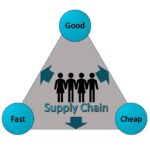E-Auctions–specifically reverse English auctions–have a bad reputation.
They had a rise and fall in the early 2000s, and have now largely settled into small impact materials bids or logistic shipping lanes. Why have they gained this reputation and been relegated to the bottom of the negotiation toolbox? Because they suffer from several key myths and misconceptions.

e-Auction Myth #1 – e-Auctions are only good for materials.
The first and most common myth is that only physical “widgets” are really suitable for e-Auction. Materials have firm scopes of work, with clear and firm pricing, and often have set engineering and testing standards. However, there is a huge opportunity in negotiating services, software, and items other than materials. To be eligible for e-Auction, a bid must have two things: a clear specification or scope of work, and a bottom-line price or value. The scope of work must be written in a way that all bidders are apples-to-apples, with clear qualified/disqualified technical criteria. This usually takes a bit more effort with services or software than with materials, but is possible. The second thing you must have to run an e-Auction is the ability to get to a bottom-line price. In a service bid for hourly rates, this might mean estimating how many hours of each role the company will use each month or year and auctioning the sum of the hourly rates multiplied by the number of hours estimated each year. For example:
| Role | Hourly Rate | Annual Hours Estimate | Total bid |
| Engineer I | $120 | 1040 | $124,800 |
| Project Manager | $150 | 500 | $75,000 |
| Administrative support | $80 | 200 | $16,000 |
| Total for Auction: | $215,800 |
Note that if the buyer chose to run this bid by simply adding up the hourly rates of each role, a supplier could lower the Project Manager rate to win the auction and then still be the highest price supplier if their Engineer I hourly rate was higher than their competitors.
e-Auction Truth #1 – Any bid with a bottom-line price and a clear scope of work can be e-Auctioned.
e-Auction Myth #2 – e-Auctions don’t account for quality or non-monetary value.
The second myth is that e-Auctions don’t allow for considerations of quality or non-monetary value. If this is true in an e-Auction program, the process is failing and not the tool. Straight-to-auction programs quickly become a “race to the bottom.” To prevent this, a buyer needs to run an RFP with clear qualification criteria ahead of the e-Auction, so the e-Auction becomes the negotiation tool instead of a replacement for the bid. This allows quality and non-monetary considerations to result in supplier qualification for e-Auction, which replaces the price negotiation portion of the bid process. An e-Auction is simply a fairer and more transparent way to do the old-fashioned “Can you sharpen your pencil?” series of phone calls that took days or weeks to complete.
e-Auction Truth #2 – An e-Auction is a tool for negotiating price after quality and non-monetary value requirements are already met.
e-Auction Myth #3 – e-Auctions cannot strengthen supplier/buyer relationships.
The third myth is that e-Auctions erode relationships between the supplier and buyer. As with anything in business, if an e-Auction program runs without the right support, it will be cold and heartless. The key components to using an e-Auction to strengthen supplier relationships are clarity and training. The company must use the auction to clearly define what is being bid and will go into the contract, ensuring the e-Auction is the final step in the bid process. Then the company must support suppliers with clear training, practice auctions, and a phone number to call in case of issues or questions. All of this helps the supplier feel they are competing in a fair playing field and can strengthen supplier relationships instead of weaken them.
e-Auction Truth #3 – With clarity and training, e-Auctions can improve supplier relationships and create a fairer competitive environment.
e-Auction Myth #4 – Sourcing software is difficult and non-intuitive.
The fourth myth is that the software systems to run e-Auctions are tricky and non-intuitive for buyers and suppliers. As with any software, this can absolutely be true. In implementing bid software, the key is to keep the software as out-of-the-box and without customizations as possible, with a ruthless priority on minimizing the number of fields suppliers and buyers must enter. A common mistake made in implementing or configuring sourcing software is to ask for dozens of fields of data in an effort to “use big data” until there is simply too much to manage. Minimize the information suppliers need to enter to participate in an auction to reduce the barriers to entry. Similarly with buyers, configure as many decisions in the default settings as possible to make building e-Auctions quick and easy.
e-Auction Truth #4 – Configuration is key in setting up e-Auction software for success, and is most successful when the number of fields or settings required is ruthlessly minimized.
e-Auction Myth #5 – An e-Auction will just chase off my incumbent supplier.
The fifth common e-Auction myth is that incumbent suppliers (those who already have the company business) will refuse to continue supplying if required to participate in an auction. This one has an element of truth to it because there are suppliers who will take this approach. However, any supplier who simply walks away without a conversation was not a supplier partner in the first place and not the kind of supplier who can help move the company forward. It is critical to have a candid conversation with incumbent suppliers about why the company is implementing an e-Auction program, and emphasize the supplier benefits of market information and scope of work clarity. A supplier who is truly a solid partner to the company will have no trouble competing in an e-Auction and winning business, and the right conversation will lead to right-sizing the business awarded to an incumbent (including increasing it!). Incumbent suppliers still have an advantage because they know what the company expects and what the company has been paying for it. They can use this information to continue to win business with the benefit of a clearer scope of work and more information about where they are positioned on price in the market.
e-Auction Truth #5 – Incumbents who are true supplier partners benefit from e-Auctions as much as the company because of their greater understanding of the company’s needs and price points.
e-Auction Myth #6 – An e-Auction will add time to the bid process.
The last myth that e-Auctions add significant time to the bid process always makes me laugh a little when I hear it. One of the great benefits of an e-Auction is that it reduces to hours or days a process that previously took weeks. In the “old way”, a buyer calls up the second place bidder on an RFP and asks if they can sharpen their pencil. The supplier responds a few days later with a small cost reduction, at which point the buyer calls up the newly second place bidder (previously the winning bidder) and asks them to sharpen their pencil. This process continues until one of the suppliers cannot reduce their price any further. All of this conversation takes place in 10-20 minutes with an e-Auction, which can be run as quickly as one day after the bid closes if the company’s process is tight. In addition, at the end of an e-Auction there is absolute clarity on what is bid. The prices and scope of work are right in the auction, are binding, and if done correctly can directly become the scope of work and pricing schedule in the contract. While adding a day or two after the bid closes and the technical evaluation is complete, the e-Auction dramatically shortens the negotiation period for contracting.
e-Auction Truth #6 – An e-Auction will add one or two business days to the proposal process, but dramatically shorten the overall competition process.
What have I missed? What objections/complaints/myths about e-Auctions have you heard that aren’t included here?



